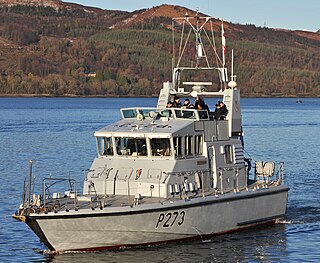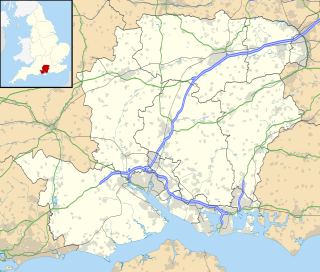
A torpedo boat is a relatively small and fast naval ship designed to carry torpedoes into battle. The first designs rammed enemy ships with explosive spar torpedoes, and later designs launched self-propelled Whitehead torpedoes. They were created to counter battleships and other slow and heavily armed ships by using speed, agility, and the power of their torpedo weapons. A number of inexpensive torpedo boats attacking en masse could overwhelm a larger ship's ability to fight them off using its large but cumbersome guns. An inexpensive fleet of torpedo boats could pose a threat to much larger and more expensive fleets of capital ships, albeit only in the coastal areas to which their small size and limited fuel load restricted them.

HMS Charity was a C-class destroyer of the Royal Navy laid down by John I. Thornycroft and Company of Woolston, Southampton on 9 July 1943. She was launched on 30 November 1944 and commissioned on 19 November 1945. She was sold to the US Navy in 1958, for transfer to the Pakistan Navy as a part of the Military Aid Program.
Seven ships of the Royal Navy have been named HMS Archer, named after a person proficient in archery - an archer:

Motor Torpedo Boat (MTB) was the name given to fast torpedo boats by the Royal Navy and the Royal Canadian Navy. The 'motor' in the formal designation, referring to the use of petrol engines, was to distinguish them from the majority of other naval craft that used steam turbines or reciprocating steam engines.

The Royal Brunei Navy is the naval defence force of Brunei Darussalam. It is a small but relatively well-equipped force whose main responsibility is to conduct search and rescue missions and to deter and defend the Brunei waters against attack mounted by sea-borne forces.

HMS Tracker is an Archer-class (P2000) patrol and training vessel of the British Royal Navy. Along with her batch 2 sister-ship, HMS Raider, Tracker is part of the Faslane Patrol Boat Squadron based at HMNB Clyde.
The Nasty type patrol boats were a series of fast patrol boats designed and built in Norway during the 1950s and '60s for the Norwegian, and other, navies.

HMS Pursuer is an Archer-class P2000 patrol and training vessel of the British Royal Navy. She is currently the training vessel of Glasgow and Strathclyde Universities Royal Naval Unit based at HMNB Clyde where she was until 2012 part of the Faslane Patrol Boat Squadron (FPBS). She has also served in Cyprus.

HMS Raider is an Archer-class patrol and training vessel of the British Royal Navy. Along with her batch 2 sister-ship, HMS Tracker, Raider is part of the Faslane Patrol Boat Squadron based at HMNB Clyde.

HMS Example is an Archer-class patrol and training vessel of the Royal Navy, based at HMS Calliope in Gateshead, England. Example was originally built for the Royal Naval Auxiliary Service, and was transferred to the Royal Navy when the RNXS disbanded in 1994. On transfer, she retained her name, and became the first ship in the Royal Navy to bear that name.

The Scimitar class is a class of fast patrol boat in service with the British Royal Navy.

HMS Simoom was a third-batch S-class submarine built for the Royal Navy during World War II. She was laid down on 14 July 1941 and launched on 12 October 1942.

HMS Gay Archer was a Gay-class fast patrol boat of the Royal Navy. She was built by Vosper, Portchester, and launched on 20 August 1952.
HM Motor Gun Boat 2007 was a Motor Gun Boat operated by Royal Navy Coastal Forces during the Second World War. She was initially built as one of eight gun boats ordered by the Turkish Navy, but which went on to see service in the North Sea as fast blockade runners. She was initially classed as the merchant vessel Gay Corsair, crewed by men of the merchant navy and sailing under the red ensign. She became HM Motor Gunboat 507 after being acquired by the Royal Navy, and finally HM Motor Gun Boat 2007. She was wrecked under this name in 1945.

The Gay class were a class of twelve fast patrol boats that served with the Royal Navy from the early 1950s. All were named after types of soldiers or military or related figures, prefixed with 'Gay'. The class could be fitted as either motor gun boats or motor torpedo boats, depending on the type of armament they carried.

Royal East African Navy was a naval force of the former British colonies of Kenya, Tanganyika, Uganda and Zanzibar. Formed in 1952 to replace Royal Navy's Naval Volunteer Reserves in Zanzibar and Tanganyika (1939) and was disbanded in 1962 with the independence of Tanganyika from Britain. The assets of the REAN was handed over to the East African Railways and Harbours Corporation.

HMS Gay Bruiser was a Gay-class fast patrol boat of the Royal Navy. She was built by Vosper, Portchester, and launched on 19 December 1952. She was the third ship to be launched in her class.

HMS Trollope (K575) was a British Captain class frigate of the Royal Navy in commission during World War II. Originally constructed as a United States Navy Buckley class destroyer escort, she served in the Royal Navy from January to July 1944, when she was lost.















